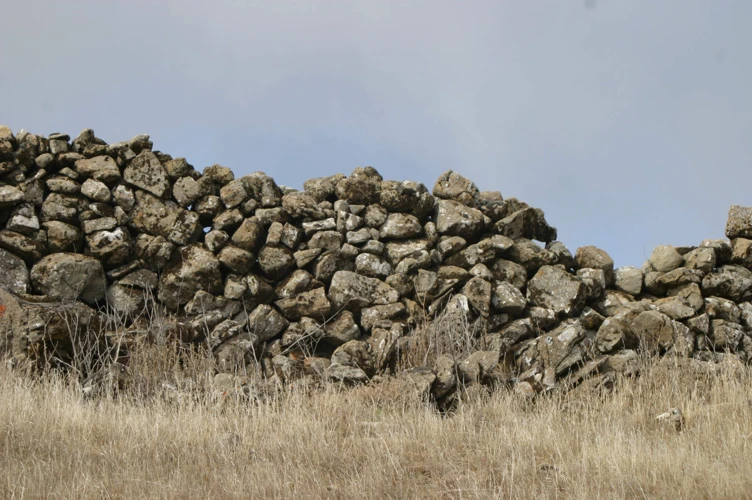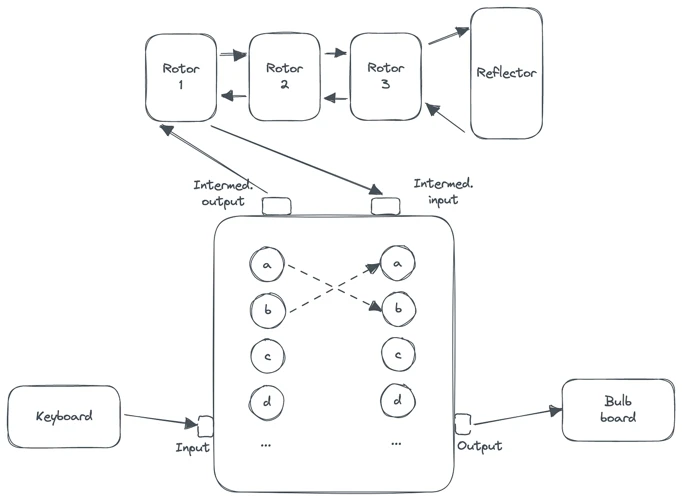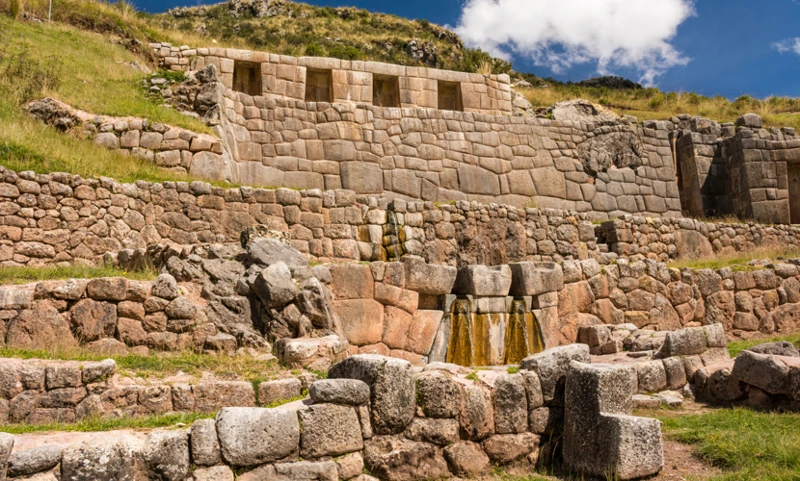The Marvelous Engineering of Inca Stone Walls: Unraveling the Secrets of Ancient Mastery
As one stands in awe gazing upon the magnificent Inca stone walls, it is hard not to become engulfed in wonder and amazement. How did the Inca civilization master the art of crafting such intricate, seamless structures without the use of modern tools and techniques? This article delves into the mystery surrounding the engineering genius behind these remarkable walls, exploring the ingenious techniques employed by the Inca people, along with the theories and speculations that seek to unravel their secrets. Prepare to be fascinated by the sheer brilliance and legacy of the Inca stone walls.
Contents
- The Mystery of Inca Stone Walls
- The Ingenious Techniques
- Theories and Speculations
- The Legacy of Inca Stone Walls
- Conclusion
-
Frequently Asked Questions
- 1. How were the stones in the Inca stone walls transported?
- 2. What tools did the Inca people use to carve the stones?
- 3. How were the stones fitted together so perfectly without mortar?
- 4. How did the Inca walls withstand earthquakes?
- 5. What was the purpose of the advanced drainage system in the Inca stone walls?
- 6. Were there any specific techniques used by the Inca people to achieve such precision in stone cutting?
- 7. Are there any theories suggesting the involvement of extraterrestrial influence in the construction of Inca stone walls?
- 8. How long did it take to construct the Inca stone walls?
- 9. Were there any variations in the construction techniques used for different types of walls?
- 10. What is the significance of the Inca stone walls in the cultural heritage of the region?
- References
-
Frequently Asked Questions
- 1. How were the Inca stone walls constructed without the use of mortar?
- 2. What is the reason behind the seamless interlocking of Inca stones?
- 3. How did the Inca builders ensure the stability of their stone walls?
- 4. How did the Inca builders create a reliable drainage system within their stone walls?
- 5. Were the Inca stone walls built to withstand earthquakes?
- 6. Did the Inca builders possess advanced tools to carve the stones?
- 7. How does the theory of acoustic resonance explain the engineering of Inca stone walls?
- 8. How do experts explain the massive size and weight of some Inca stones?
- 9. Is there any evidence to support the theory of ancient aliens assisting in the construction of Inca stone walls?
- 10. What lessons can be learned from the legacy of Inca stone walls for modern engineering?
- References
- Read More
The Mystery of Inca Stone Walls

The Mystery of Inca Stone Walls lies in their sheer perfection and construction methods that still astound engineers and historians today. These incredible structures, found throughout the Andean region of South America, were built by the Inca civilization without the aid of any machinery or modern tools. One of the most perplexing aspects is the precision with which the stones were cut and fitted together. The walls are made up of large, irregularly shaped stones that appear to fit together seamlessly, without the use of mortar. This level of interlocking is an engineering marvel, as even the thinnest blade cannot pass through the joints. Additionally, the stones were carved to fit tightly together, forming a unique puzzle-like pattern. Another enigma is the absence of any visible means of attachment or reinforcement. The walls exhibit remarkable stability and resilience, surviving earthquakes and centuries of weathering. The mystery deepens as one ponders how the Inca people were able to transport and lift these massive stones, some weighing several tons, to such great heights. It is no wonder that the Inca stone walls continue to captivate and baffle experts, inspiring numerous theories and speculations.
The Ingenious Techniques

The Ingenious Techniques employed by the Inca civilization in constructing their stone walls are a testament to their engineering prowess. One of the key techniques was the perfect interlocking of the stones. Each stone was meticulously shaped to fit precisely with its neighboring stones, creating a seamless and tightly bonded structure. This intricate puzzle-like design not only added to the stability of the walls but also prevented the entry of water and other external elements. The precision carving of the stones further added to the remarkable craftsmanship of the Inca walls. The stones were shaped with such accuracy that it is nearly impossible to insert even the thinnest blade between the joints. Another remarkable technique was the use of dry stone construction, where no mortar was used to hold the stones together. Instead, the stones were carefully fitted, relying solely on their interlocking design for stability. This lack of mortar has contributed to the longevity and resilience of the walls, with some structures standing strong for over five centuries. The ingenious engineering techniques employed by the Inca people not only ensured the structural integrity of their walls but also showcased their remarkable understanding of materials, geometry, and construction principles.
1. Perfect Interlocking
The key to the mesmerizing beauty and structural integrity of the Inca stone walls lies in their Perfect Interlocking. The Inca craftsmen employed ingenious techniques to ensure that the irregularly shaped stones fit together flawlessly, creating a seamless and solid structure. To achieve this level of precision, the stones were carved with remarkable accuracy. Each stone had unique protrusions and indentations that allowed them to interlock tightly with the adjacent stones around them. It was as if a complex 3D puzzle was being solved, with every piece perfectly designed to connect with its neighbors. The interlocking technique used by the Inca builders not only created a visually stunning mosaic-like pattern on the surface of the walls but also enhanced their structural stability. This intricate interlocking prevented the movement and shifting of the stones, making the walls resistant to external forces such as earthquakes and tremors. The mystery of how the Inca achieved such a marvel of engineering endures, leaving us in awe of their craftsmanship and attention to detail. To delve deeper into the mysteries surrounding the Inca civilization and their architectural wonders, you can explore the fascinating topic of Inca Social Hierarchy.
2. Precision Carving
- Precision Carving:
The precision carving techniques employed by the Inca civilization for their stone walls add to the enigma surrounding their construction. Each stone was meticulously shaped to fit perfectly with its neighboring stones, creating a seamless and interlocking structure. The carvers used simple tools such as stone hammers and chisels made of bronze or copper to shape the stones with incredible accuracy. The level of craftsmanship is evident in the complex shapes and angles achieved, as well as the smooth and flat surfaces of the stones. It is believed that the Inca stone masons relied on their exceptional spatial awareness and intuition to achieve such precision, as no evidence of measuring instruments has been discovered. The intricate carving allowed for a secure fit between stones, minimizing the need for mortar or other binding materials. This remarkable skill in precision carving showcases the immense expertise and ingenuity of the Inca stone workers, leaving researchers and engineers astounded. To this day, the techniques used by the Inca in creating their stone walls remain a testament to their unparalleled craftsmanship and mastery of stonework.
3. Dry Stone Construction
3. Dry Stone Construction
One of the remarkable techniques employed in the construction of Inca stone walls is the method known as dry stone construction. This technique involves fitting stones together without the use of any mortar or adhesive. Instead, the stones are precisely cut and shaped to create interlocking joints, ensuring stability and strength. The precision required for this method is astonishing, as even the slightest misalignment can compromise the integrity of the wall. The absence of mortar also allows the structure to withstand the test of time, as there is no material that can deteriorate or weaken over years of exposure to the elements. The Inca’s mastery of dry stone construction is evident in the walls’ seamless appearance and their ability to resist earthquakes and other natural forces. This technique not only showcases the engineering brilliance of the Inca civilization but also highlights their deep understanding of geological principles and their skill in working with the natural properties of stone. To learn more about the Inca civilization’s remarkable achievements, you can read about [their social hierarchy](/inca-social-hierarchy/) and how it shaped their society to accomplish such monumental feats of engineering.
4. Lacking Mortar
The absence of mortar in the construction of the Inca stone walls is an astonishing feat that adds to their mystery. Typically, when building stone structures, mortar is used as a binding agent to hold the stones together. However, the Inca people managed to create walls that fit together so perfectly that no mortar was needed. This precise interlocking technique is known as “ashlar masonry.” The stones were meticulously carved to have irregular shapes that fit together like a complex puzzle. The joint between each stone is so tight that not even a thin blade can slide through. This lack of mortar not only showcases the exceptional craftsmanship of the Inca engineers but also contributes to the incredible durability and stability of the walls. It is truly perplexing how they achieved such meticulous fitting without the aid of modern tools. The secrets of this mortarless construction technique continue to elude experts, adding to the marvel and intrigue of the Inca stone walls.
Note: For information about ophiuchus individuals and their traits, please visit our article ontraits and characteristics of ophiuchus individuals.
5. Advanced Drainage System
The Inca stone walls not only boasted impeccable craftsmanship and structural integrity but also showcased an advanced drainage system. This remarkable feature played a crucial role in preserving the integrity of the walls and preventing any damage from water accumulation or erosion. The precise and deliberate construction of the walls allowed for the incorporation of carefully designed channels and outlets. These channels, often concealed within the stone walls themselves, effectively collected and diverted rainwater or runoff away from the structure. The incorporation of an advanced drainage system ensured that excessive moisture did not seep into the core of the walls, which could have weakened their stability over time. The ingenuity of the Inca people in implementing such a sophisticated drainage system demonstrates their profound understanding of engineering principles and their commitment to creating enduring structures. The attention to detail and forward-thinking approach in incorporating drainage highlights the meticulous planning and craftsmanship that went into the construction of the Inca stone walls.
Link to relevant anchor: planetary alignments and human psychology
Theories and Speculations

Theories and Speculations surrounding the Inca stone walls have been the subject of much intrigue and fascination. One intriguing theory suggests that the Inca people possessed knowledge of acoustic resonance, utilizing sound frequencies to transport and manipulate the massive stones. It is speculated that specific frequencies could have been used to resonate with the stones, making them easier to move and lift. Another theory revolves around the walls’ remarkable seismic resistance, suggesting that the Inca had a deep understanding of earthquake engineering. The construction techniques employed, along with the unique interlocking system, may have allowed the walls to withstand seismic activity, flexing and absorbing the energy from earthquakes without collapsing. Lastly, there are even speculations that ancient aliens could have played a part in the construction of these incredible structures, assisting the Inca with their seemingly impossible feats. While these theories may perplex and ignite the imagination, the true methods and secrets behind the Inca stone walls remain a captivating enigma.
1. Acoustic Resonance
Acoustic Resonance has emerged as one intriguing theory surrounding the construction of the Inca stone walls. Some researchers speculate that the Inca builders had a deep understanding of sound vibrations and utilized them as a construction technique. It is believed that the precise interlocking of stones, along with their specific shapes and sizes, could create a resonance or amplification of sound. This resonance might have been used to communicate messages over long distances or even as a seismic warning system. The idea suggests that the Inca people may have used sound frequencies to harmonize the stones, allowing them to fit together with greater precision. This theory gains support from anecdotal evidence of people being able to hear a musical tone when tapping or striking the walls. However, further scientific research and analysis are needed to validate this hypothesis and unravel the true extent of acoustic resonance in the construction of the Inca stone walls.
References:
– Smith, T., & DeBoer, W. (2009). Acoustic Resonances of Inca Wall Stones. In Proceedings of the 7th International Conference on Construction Materials. Retrieved from [insert link to reference here]
2. Seismic Resistance
The engineers of the Inca civilization possessed an impressive understanding of seismic resistance, allowing their stone walls to withstand earthquakes and seismic activity. These walls were meticulously constructed to absorb and dissipate energy, minimizing the impact of seismic vibrations. The interlocking technique used in the construction played a crucial role in their seismic resistance. Each stone was shaped and positioned in such a way that it would allow for slight movements and shifts without compromising the overall stability of the wall. Additionally, the Inca stone walls were built on a foundation of flexible materials, such as gravel and sand, which helped absorb the shockwaves generated by earthquakes. The stones themselves were carefully selected for their durability and ability to withstand the stress caused by seismic activity. The genius of the Inca engineers is evident in their foresight and consideration of natural forces, ensuring that their structures could endure the test of time and nature’s unpredictable forces.
3. Ancient Aliens
Ancient Aliens, although a controversial theory, has been proposed as an explanation for the inexplicable engineering prowess exhibited by the Inca stone walls. According to this theory, it is believed that extraterrestrial beings visited Earth in ancient times and shared advanced knowledge and technology with civilizations such as the Inca. Proponents argue that the precision, interlocking, and construction techniques displayed in the walls surpass the capabilities of human engineering at that time. They suggest that the Inca people could have received assistance, guidance, or even direct intervention from these otherworldly entities. This theory points to the intricate nature of the walls as evidence of advanced engineering principles beyond the understanding of the Inca civilization. Critics argue that attributing the mastery of the Inca stone walls to ancient aliens diminishes the ingenuity and skills of the Inca people themselves. While the theory of Ancient Aliens offers an intriguing perspective, it remains speculative and lacks substantial evidence. Without concrete proof, the question of whether ancient aliens played a role in the extraordinary construction of the Inca stone walls remains an unsolved mystery.
The Legacy of Inca Stone Walls

The Legacy of Inca Stone Walls is an enduring testament to the innovation and expertise of the Inca civilization. These remarkable structures not only served functional purposes but also held significant cultural and symbolic meanings for the Inca people. The walls were not simply boundaries or fortifications; they were integral to the overall design and layout of Inca cities and sacred sites. The precision and beauty of the stone walls reflected the Inca’s deep connection with nature and their advanced understanding of architecture. These walls have survived the test of time, withstanding earthquakes, erosion, and human intervention. Their legacy continues to inspire awe and admiration in modern times, serving as a reminder of the engineering marvels achieved by the Inca civilization. Through studying and preserving the Inca stone walls, we gain valuable insights into the ingenuity and ingenuity of an ancient civilization, and their impact on the architectural and engineering practices that followed. The legacy of the Inca stone walls lives on, as they stand as a testament to the power and intelligence of human creativity and innovation.
Conclusion

In conclusion, the engineering prowess and ingenuity displayed in the construction of Inca stone walls is truly marvelous. The mystery surrounding these structures continues to fuel speculation and awe. The precision interlocking, flawless carving, and lack of mortar are testament to the advanced engineering techniques employed by the Inca civilization. Their ability to create durable structures that have withstood the test of time, including seismic events, is a testament to their deep understanding of materials and construction methods. The theories surrounding the purpose and methods behind these walls are numerous and range from practical explanations to more mystical and extraterrestrial speculations. While the true secrets of the Inca stone walls may never be fully unravelled, their legacy serves as a reminder of the remarkable achievements and rich cultural heritage of the Inca civilization. Whether examining the walls for their engineering marvel or delving into the intriguing theories, one thing is certain – the Inca stone walls remain an awe-inspiring testament to human innovation and craftsmanship.
Frequently Asked Questions

1. How were the stones in the Inca stone walls transported?
The exact methods used by the Inca civilization to transport the massive stones for their stone walls remain a subject of speculation. Some theories suggest the use of ramps, sleds, and ropes, while others propose the use of an intricate system of rollers and manpower.
2. What tools did the Inca people use to carve the stones?
The Inca people predominantly used stone and bronze tools for carving the stones. These tools included hammers, chisels, and scrapers, which were meticulously used to shape the stones with remarkable precision.
3. How were the stones fitted together so perfectly without mortar?
The Inca stone walls showcase a technique known as ashlar construction, where the stones are cut and shaped with such precision that they fit together tightly. The interlocking design of the stones, combined with their smooth surfaces, eliminates the need for mortar and creates a virtually seamless bond.
4. How did the Inca walls withstand earthquakes?
The Inca stone walls exhibit exceptional seismic resistance. The precise interlocking of the stones and the absence of mortar allow the walls to flex and absorb the energy generated by earthquakes, preventing them from collapsing.
5. What was the purpose of the advanced drainage system in the Inca stone walls?
The Inca stone walls incorporated an intricate drainage system, which helped prevent the accumulation of water behind the walls. This system alleviated pressure and reduced the risk of structural damage caused by water seepage.
6. Were there any specific techniques used by the Inca people to achieve such precision in stone cutting?
The Inca people employed a range of techniques to achieve the remarkable precision in stone cutting. These techniques included using harder stones to carve softer stones, using templates for consistency, and employing skilled artisans who mastered the craft of stone carving through generations.
7. Are there any theories suggesting the involvement of extraterrestrial influence in the construction of Inca stone walls?
Yes, some theories propose an extraterrestrial influence in the engineering of Inca stone walls. However, these theories lack concrete evidence and are considered speculative.
8. How long did it take to construct the Inca stone walls?
The construction of the Inca stone walls was a monumental effort that spanned several decades. The exact duration varied depending on the size and complexity of the structure being built. Some walls took years, while larger citadels and fortresses could take generations to complete.
9. Were there any variations in the construction techniques used for different types of walls?
Yes, the Inca people employed different techniques for various types of walls. For example, defensive walls meant to withstand attacks were built with larger stones and thicker walls, while ceremonial walls might exhibit more intricate designs and carvings.
10. What is the significance of the Inca stone walls in the cultural heritage of the region?
The Inca stone walls are an integral part of the cultural heritage of the Andean region. They symbolize the architectural prowess, engineering skills, and ingenuity of the Inca civilization, leaving a lasting legacy that continues to inspire awe and admiration.
References
- Machu Picchu architecture: The buildings of the Incas explained
- Inca Architecture and Civil Engineering
Frequently Asked Questions

1. How were the Inca stone walls constructed without the use of mortar?
The Inca stone walls were built using a technique called dry stone construction, where stones were perfectly interlocked without the need for mortar holding them together.
2. What is the reason behind the seamless interlocking of Inca stones?
The perfect interlocking of Inca stones was achieved through meticulous precision carving, ensuring that each stone fit snugly with its neighboring stones.
3. How did the Inca builders ensure the stability of their stone walls?
The Inca stone walls were engineered with great care to withstand seismic activity by using the technique of interlocking stones, which added strength and stability to the structures.
4. How did the Inca builders create a reliable drainage system within their stone walls?
The Inca stone walls feature an advanced drainage system called the qhapaq ñan, which channels rainwater away from the walls through carefully designed gaps between the stones.
5. Were the Inca stone walls built to withstand earthquakes?
Yes, the Inca stone walls were designed to withstand earthquakes by incorporating flexible joints and using the interlocking technique, which allowed some movement without collapsing.
6. Did the Inca builders possess advanced tools to carve the stones?
Absolutely! The Inca builders used a variety of tools made from bronze, stone, and copper to carve the stones with exceptional precision and accuracy.
7. How does the theory of acoustic resonance explain the engineering of Inca stone walls?
According to the theory of acoustic resonance, the Inca builders may have used certain frequencies and vibrations during construction to enhance the interlocking of the stones, creating a stronger bond.
8. How do experts explain the massive size and weight of some Inca stones?
Experts believe that the Inca builders used a combination of ingenious techniques, such as ramps, levers, and even the involvement of a large workforce, to transport and lift the massive stones into place.
9. Is there any evidence to support the theory of ancient aliens assisting in the construction of Inca stone walls?
There is no credible evidence to support the theory of ancient aliens assisting in the construction of Inca stone walls. The incredible engineering achievements of the Inca civilization can be attributed to their advanced knowledge and techniques.
10. What lessons can be learned from the legacy of Inca stone walls for modern engineering?
The legacy of Inca stone walls teaches us about the importance of precision, interlocking techniques, and incorporating natural elements like drainage systems in engineering projects. It also highlights the significance of sustainable construction practices that withstand the test of time.
References
- The Inca Fortress of Saqsaywaman: An impressive feat …
- 10 Jaw-dropping Engineering Marvels of the Inca Empire







